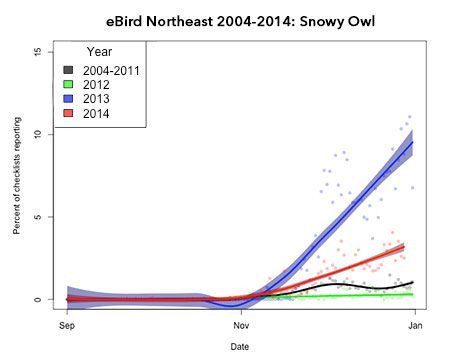A Snowy Owl Sequel?
By Pat Leonard January 16, 2015

Last year’s blizzard of Snowy Owls in the Great Lakes states, the Northeast, and down the Atlantic Coast was epic, an unprecedented irruption.
Now some birders are asking, is it happening again?
Snowy Owls are being seen and reported on eBird this winter across the northern-third of the Lower 48 states from Washington state to Maine, with some reports of snowies as far south as Oklahoma and Maryland.
Scientists surmise that last year’s large southward sweep of Bubo scandiacus east of the Mississippi River was triggered by a record nesting season among the breeding population in northern Quebec.


When it came time for fledglings to disperse, some among the bumper crop of young snowies had to travel far south to find food. The majority of Snowy Owls seen in the Lower 48 states last year were young males.
This past summer, there was another bumper crop—this time in Nunavut. Researchers from Canada’s Laval University reported record numbers of Snowy Owls nesting on Bylot Island. The previous high found in and around their research plot was 33 nests in 2010; this year they found 116 nests.
So this winter’s Snowy Owls could be returnees from northern Ontario, new birds from Nunavut, or a mix of both. A Snowy Owl geotracking effort called Project SNOWstorm may help answer that question. (See Science from a Snowstorm below.)


According to Marshall Iliff, a project leader on the Cornell Lab of Ornithology’s eBird team, this year’s winter Snowy Owl flight into the Lower 48 is impressive but not at the scale of last year’s irruption. For comparison, last winter a 5-state block in the Northeast had more than 8,000 reports of Snowy Owls from November to January. This winter that same block has had 1,200 snowy reports so far.
Still, Iliff says, it’s an above-average winter for snowies.
“This flight can be thought of as an echo flight,” said Iliff. “Echo flights are above average flight years following a very above average year. The exact cause is unknown and might be related to good summer food resources [lemmings] continuing from the previous year, another region with above average food resources, or possibly one-year-old birds returning south via last year’s route.”
For up-to-date reports on where snowies are being seen this winter, check out this custom eBird Snowy Owl map. You can also sign up for eBird’s Snowy Owl alert service.
Science from a Snowstorm
Very little is known about where Snowy Owls go when they travel back north after an irruption. So with snowies in spades last winter, noted naturalist/author Scott Weidensaul helped organize a scientific effort called Project SNOWstorm to put solar-powered data loggers on Snowy Owls and track their movements.


Last winter the project tagged 22 owls in 7 states. Now they’re waiting for some of these owls to return. Their data loggers will download automatically once they’re within cellular signal range.
So far this winter three tagged owls have flown back within cell range in southern Ontario. The downloaded data from one owl showed that it flew 1,200 miles north from where it was tagged in Erie, Pennsylvania, to spend summer in the subarctic tundra near the Hudson Strait. This may be where this owl was born, since it’s the area of northern Quebec that had a record Snowy Owl nesting season. By October, the owl had flown back south to the St. Lawrence River Valley along the Ontario–New York border.
The SNOWstorm team hopes to tag another eight to 10 owls this winter. If they do, scientists may be able to determine if this winter’s owls return to Ontario, Nunavut, or somewhere else during the breeding season.
To see project updates, visit the Project SNOWstorm blog.
For more about Snowy Owls:
- Project SNOWstorm Seizes the Moment to Take a Closer Look at Snowy Owls
- Species on the move: Snowy Owl, from the Cornell Lab’s BirdCast migration forecasting project website, analyzes how last year’s Snowy Owl irruption compares to this year’s.
- A Season of Snowy Owls, in the Spring 2014 Living Bird magazine
- Banding Snowy Owl Chicks With Researcher Denver Holt
- A Live Visit to the Snowy Owl Nest on Our Live Cam
- Send in your Snowy Owl photos that show spread wings or tails—this will help scientists determine the age and gender of the birds


All About Birds is a free resource
Available for everyone,
funded by donors like you


